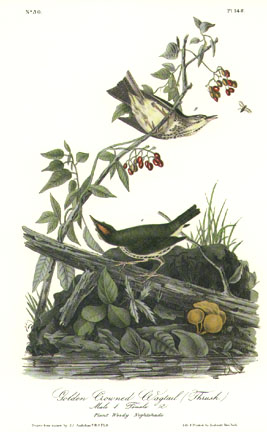

148 GOLDEN-CROWNED WAGTAIL
| The notes of this bird are first heard in Louisiana, about the
beginning of March. Some individuals remain there all summer, but the
greater number proceed eastward, some going as far as Nova Scotia, while
others move towards the west. Over all this extent of country the
species is dispersed, and its breeding places are in the interior or
along the margins of shady woods watered by creeks and rivulets, and
seldom visited by man, it being of a shy and retiring disposition, so
that its occurrence in the open parts of the country is very rare. In
places like these, it settles for the season, attunes its pipe to its
simple lay, forms its nest, rears a brood or two, and at the approach of
winter, spreads its wings and returns to southern regions.
Perched erect on a low horizontal branch, or sometimes on a fallen tree, it emits, at intervals of ten or fifteen minutes, a short succession of simple notes, beginning with emphasis and gradually falling. This suffices to inform the female that her lover is at hand, as watchful as he is affectionate. The quieter the place of his abode, the more the little minstrel exerts his powers; and in calm evenings, its music immediately following the song of the Tawny Thrush, appears to form a pleasant unison. The nest is so like an oven, that the children in many places call this species the "Oven Bird." I have found it always on the ground, sometimes among the roots of a tall tree, sometimes by the side of a fallen trunk, and again at the foot of some slender sapling. It is sunk in the ground among dry leaves or decayed moss, and is neatly formed of grasses, both inside and out, arched over with a thick mass of the same material, covered by leaves, twigs, and such grasses as are found in the neighbourhood. A small aperture is left on one side, just sufficient to admit the owner. In this snug tenement the female deposits from four to six eggs, which are white, irregularly spotted with reddish-brown near the larger end. When accidentally disturbed at the period of incubation, it glides over the ground before you, and uses all sorts of artifices to decoy you from its nest. Several species of snakes and small quadrupeds are its principal enemies. From children it has little to dread, its gentleness securing it a place in their affections, so that they seldom molest it. While on wing it appears to glide through the woods with ease and celerity, although it seldom extends its flight to more than a hundred yards at a time. It migrates by day, resorting at night to the deepest swamps. In these situations I have met it in company with the Cat-bird and other Thrushes. When disturbed on such occasions, its simple tweet was familiar to my ear. None remain in the United States during winter, although some are found lingering in the lower parts of Louisiana as late as the first of December. The plant on which I have placed a pair of them, grew near the spot where I obtained the birds, in a dark wood not far from Philadelphia. Mr. TOWNSEND brought specimens of this bird from the Columbia river, but he did not find it on the Rocky Mountains, although it inhabits the plains of the Missouri. Dr. RICHARDSON informs us that it breeds on the banks of the Saskatchewan river, and perhaps still farther northward. I found it abundant in the Texas, about the middle of May, and have reason to think that it breeds there. The eggs measure seven-eighths in length, and five-eighths in breadth. The nest somewhat resembles in form that of the European Dipper, although it is far from being so substantially built, or so large. From Texas eastward. Fur Countries. Not seen in Labrador. Throughout the interior. Resident in Florida, Louisiana, and Texas. Abundant. GOLDEN-CROWNED THRUSH, Turdus aurocapillus, Wils. Amer. Orn., vol.
ii.p. 88. SEIURUS AUROCAPILLUS, Golden-crowned accentor, Swains. & Rich. F. Bor. Amer., vol. ii. p. 227. GOLDEN-CROWNED THRUSH or OVEN-BIRD, Turdus aurocapillus, Nutt. Man.,vol. i. p. 355. GOLDEN-CROWNED THRUSH, Turdus aurocapillus, Aud. Orn. Biog., vol. ii.p. 253; vol. v. p. 447. Upper parts yellowish-olive, the crown brownish-orange, with two lateral bands of brownish-black spots; lower parts white, the throat with two lateral lines of brownish-black, the lower neck, fore part of breast, and sides, marked with triangular spots of the same. Female similar to the male. Young without the orange crown. Male, 6, 9. THE WOODY NIGHTSHADE. SOLANUM DULCAMARA, Willd., Sp. Pl., vol. i. p. 1027. Pursch, Fl. Amer. Sept., vol. i. p. 156.--PENTANDRIA MONOGYNIA, Linn. This species is found in the woods, as well as along the margins of cultivated land, and is one of those common to both continents.
|